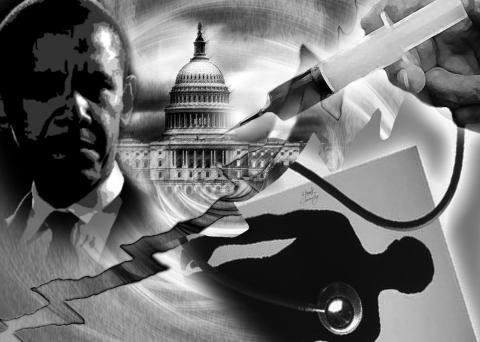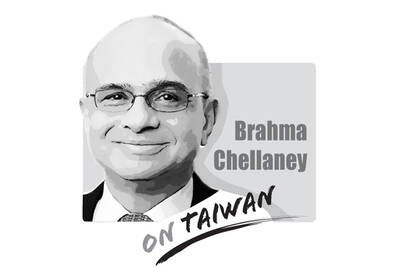With the US Supreme Court considering the Affordable Care Act (the historic healthcare reform derided by opponents as “Obamacare”), it is worth noting that the number of people in the US without health insurance reached an all-time high in 2010, the year the law was enacted. About 50 million US residents (one in six) pay out-of-pocket for medical expenses.
The 2008 recession is not the only reason for this staggering figure; long-term political and policy choices are also to blame. Globally, but especially for rapidly growing economies, the lesson is simple: Avoid the US’ private healthcare model.
The US is one of the few high-income countries that does not finance healthcare through a publicly funded prepaid system. On average, wealthier countries spend about 11 percent of their GDP on health, with more than 80 percent publicly financed and only 14 percent of spending taking place on a fee-for-service basis. Public finance (or, in some cases, government-regulated cooperative insurance funds that amount to public financing) pays for most discretionary medical services, with private insurance supplementing only minimal extra services.

Most rich countries choose to finance their healthcare publicly for several reasons. First, free-market healthcare is usually inequitable and inefficient. Individual needs vary significantly and private companies are often unwilling to insure the very people who need the most care (such as those who are already ill, or who have conditions like diabetes, which predispose them to other health problems). Moreover, those who buy care — insurers and patients — are unlikely to have the information necessary to choose the safest and most effective treatments.
At the same time, public spending acts as a brake on overall spending and prevents the rapid cost escalation to which the US’ private insurance companies contribute. The US spends 1 percent of its GDP annually simply to administer its complex, unwieldy insurance system. Without reform of the type now before the Supreme Court, total US health expenditures will rise from 16 percent of GDP today to 25 percent by 2025.
The economic impact of the current system already is severe. The last US census showed a marked increase in the number of Americans living below the poverty line, a fact closely related to lack of health insurance, which in turn reflects over-reliance on employer-based insurance coverage.
In emerging-market economies, governments should bear in mind five considerations when devising healthcare systems. First, investments in health provide an important safety net against poverty traps, especially in times of economic upheaval. For example, each year, 37 million uninsured Indians fall below the poverty line because of catastrophic health expenditures (generally defined as costs exceeding 10 percent of a household’s total expenditures).
Second, public financing of healthcare frees the poor to use their money to satisfy other needs. In low-income countries, half of all healthcare spending (about 2.5 percent of GDP) is out-of-pocket (compared with 2 percent in middle-income countries). This spending consumes a large proportion of poorer households’ income, precludes more productive household investments, creates few jobs and often remains untaxed, as doctors and hospitals are frequently paid under the counter.
Third, publicly financing health could increase overall employment. Canada’s provinces phased in national health insurance from 1961 to 1975. Employment and wages rose where the program was introduced, even though average working hours were unchanged. Provinces with high levels of private insurance coverage, on the other hand, had lower employment rates and slower wage growth. More recently, Canada beat the US in a bid for a new Toyota plant, in part because private health-insurance costs in the US add several thousand dollars to the cost of manufacturing a car there.
Fourth, existing national healthcare systems in wealthier countries can serve as models for emerging-market economies that choose to adopt similar systems. Importantly, public finance need not mean only public delivery; private hospitals and clinics can sometimes deliver services more effectively. Taiwan initiated a single-payer system in 1995, significantly curbing healthcare costs and improving the population’s quality of life. Mexico’s new universal health-insurance system was implemented first in the poorest parts of the country.
China, on the other hand, provides a sobering example of the consequences of withdrawing publicly financed health insurance. In the early 1980’s, market reforms left about 100 million rural citizens without insurance, almost overnight. Out-of-pocket costs skyrocketed, infant mortality rates stopped declining and the disease surveillance system was weakened, which may have contributed to the SARS epidemic in 2002-2003, which took more than 900 lives worldwide and caused economic losses worth an estimated US$60 billion. The Chinese government has acknowledged that the reforms were a flop and has committed to spending several billion dollars on publicly financed healthcare.
Finally, following the principle, “everyone is covered, but not everything is covered,” governments must investigate which services are most cost-effective and which should not be publicly financed, because they are both expensive and ineffective. The list of insured services can always grow in step with incomes and government revenues. In particular, higher tobacco taxes yield a double benefit: they reduce smoking, a leading cause of adult death, and raise revenue.
China, India and South Africa have all committed to adopting national health insurance. Which country achieves this goal first will depend not only on revenue, but also on the political will to overcome vested interests. It will also depend on institutions’ ability to design rational healthcare, monitor delivery and properly assess new treatments.
Healthcare costs in the US are exorbitant, with low value for money. One can only hope that “Obamacare,” together with the models being implemented by the US’ future competitors, will nudge the US to adopt a long overdue universal, publicly financed healthcare system.
Prabhat Jha is chair of Disease Control at the University of Toronto and director of the Center for Global Health Research at St Michael’s Hospital. Dean Jamison is professor of Global Health in the Department of Global Health at the University of Washington.
Copyright: Project Syndicate

Donald Trump’s return to the White House has offered Taiwan a paradoxical mix of reassurance and risk. Trump’s visceral hostility toward China could reinforce deterrence in the Taiwan Strait. Yet his disdain for alliances and penchant for transactional bargaining threaten to erode what Taiwan needs most: a reliable US commitment. Taiwan’s security depends less on US power than on US reliability, but Trump is undermining the latter. Deterrence without credibility is a hollow shield. Trump’s China policy in his second term has oscillated wildly between confrontation and conciliation. One day, he threatens Beijing with “massive” tariffs and calls China America’s “greatest geopolitical
On Sunday, 13 new urgent care centers (UCC) officially began operations across the six special municipalities. The purpose of the centers — which are open from 8am to midnight on Sundays and national holidays — is to reduce congestion in hospital emergency rooms, especially during the nine-day Lunar New Year holiday next year. It remains to be seen how effective these centers would be. For one, it is difficult for people to judge for themselves whether their condition warrants visiting a major hospital or a UCC — long-term public education and health promotions are necessary. Second, many emergency departments acknowledge
US President Donald Trump’s seemingly throwaway “Taiwan is Taiwan” statement has been appearing in headlines all over the media. Although it appears to have been made in passing, the comment nevertheless reveals something about Trump’s views and his understanding of Taiwan’s situation. In line with the Taiwan Relations Act, the US and Taiwan enjoy unofficial, but close economic, cultural and national defense ties. They lack official diplomatic relations, but maintain a partnership based on shared democratic values and strategic alignment. Excluding China, Taiwan maintains a level of diplomatic relations, official or otherwise, with many nations worldwide. It can be said that
Chinese Nationalist Party (KMT) Chairwoman Cheng Li-wun (鄭麗文) made the astonishing assertion during an interview with Germany’s Deutsche Welle, published on Friday last week, that Russian President Vladimir Putin is not a dictator. She also essentially absolved Putin of blame for initiating the war in Ukraine. Commentators have since listed the reasons that Cheng’s assertion was not only absurd, but bordered on dangerous. Her claim is certainly absurd to the extent that there is no need to discuss the substance of it: It would be far more useful to assess what drove her to make the point and stick so